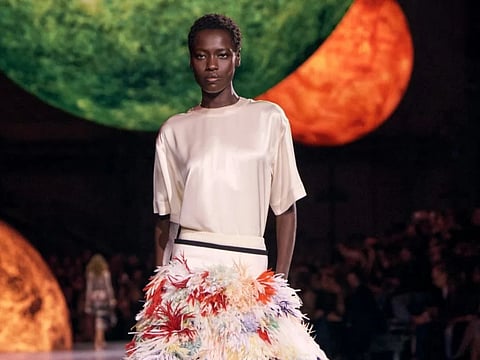The Kurator's Paris Fashion Week Spring/Summer 2026 highlights part 3
Designers approached heritage not as a script to follow but as material to rework

Paris Fashion Week’s Spring/Summer 2026 shows felt like a reset. Designers approached heritage not as a script to follow but as material to rework. Valentino, Alexander McQueen and Chanel led the conversation, while Chloé, Miu Miu and Zimmermann added depth and contrast to the season’s narrative.
Themes of transformation, modern femininity and strength dominated the week. The result was less about fantasy and more about attitude - designers reclaiming craft as a statement of intent.
Valentino
At Valentino, Alessandro Michele swapped grandeur for intimacy. His collection, titled Fireflies, looked at the idea of light - how it shifts, flickers and softens rather than blinds.
Lace, silk and organza appeared alongside crisp tailoring, the balance between delicacy and structure forming the heart of the show. Oversized bows and subtle shimmer replaced heavy embellishment. The palette - pinks, yellows and soft blues anchored by beige and black - gave the collection an understated rhythm.
It was a measured evolution for Michele, one that showed restraint ithout losing the romantic edge that defines his work.
Chloé
Chemena Kamali’s Chloé continued its move toward grounded femininity. SS/26 offered a mix of light cotton dresses, cropped jackets and neat blazers, with soft floral prints recalling the brand’s 1970s roots.
The look was less bohemian daydream and more city-ready: modern, wearable and confident. It captured Kamali’s approach - a designer interested in women’s lives rather than fashion theatre.
Alexander McQueen
Seán McGirr’s collection for McQueen drew on The Wicker Man, a reference that felt fitting for a brand rooted in ritual and transformation.
He stripped back the drama and focused on form - strong jackets with uneven hems, low-slung trousers, corsetry made loose and wearable. The house’s famous bumster returned, reworked rather than revived. What first looked like floral prints revealed insect forms, a nod to nature’s precision and unease.
The collection was darker in tone but modern in execution: clothes that questioned power, rather than simply displaying it.
Miu Miu
Miuccia Prada’s Miu Miu turned its attention to uniforms and domestic workwear. Aprons, utility dresses and heavy cotton shirts were recut, layered and styled with purpose.
The effect was both subversive and pragmatic - clothes that nodded to work but refused to play the part. Rugged leathers sat next to lightweight floral prints, reflecting a designer who continues to treat contradiction as a design principle.
Zimmermann
Zimmermann brought its Australian ease to Paris once again, this time inspired by Lavender Bay in the 1970s. Floaty dresses and soft tie-dye effects came with a firmer hand: neat shirting, high-waisted trousers, leather coats.
The collection balanced prettiness with polish - relaxed but finished, easy but intentional. It showed a brand learning how to translate beach-born romance into urban relevance.
Chanel
All eyes were on Matthieu Blazy’s debut for Chanel. His first collection marked a decisive shift in tone - still Chanel, but looser, lighter, more exploratory.
The show took place beneath a huge, suspended installation at the Grand Palais, an echo of Chanel’s cosmic motifs. Tweed was deconstructed into airy knits and semi-transparent fabrics; camellias became abstract prints. Jewellery looked futuristic: glass orbs, enamelled cuffs, layered chains.
Blazy’s approach felt pragmatic rather than nostalgic. He’s not discarding Chanel’s codes - he’s editing them for a generation that values ease as much as elegance.
Sign up for the Daily Briefing
Get the latest news and updates straight to your inbox


